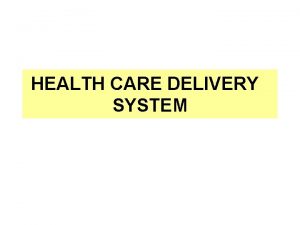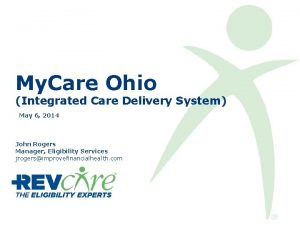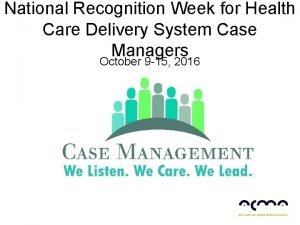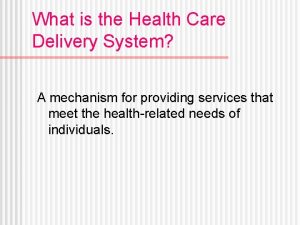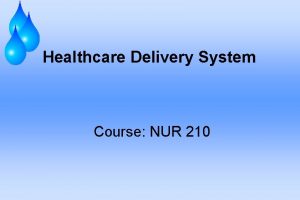Chapter 11 The Health Care Delivery System Copyright































- Slides: 31

Chapter 11 The Health Care Delivery System Copyright © 2011 Wolters Kluwer Health | Lippincott Williams & Wilkins

IOM’s Six Outcomes for a New Health System for the 21 st Century • Safe • Effective • Efficient • Patient-centered • Timely • Equitable Copyright © 2019 Wolters Kluwer • All Rights Reserved

Health Care: The Big-Picture Issues • Access to health care • Quality and safety • Affordability Copyright © 2019 Wolters Kluwer • All Rights Reserved

Characteristics of a Continuously Learning Health Care System • Science and informatics: real-time access to knowledge; digital capture of the care experience • Patient–clinician partnerships: engaged, empowered patients • Incentives: aligned for value; full transparency • Continuous learning culture: leadership-instilled culture of learning; supportive system competencies Copyright © 2019 Wolters Kluwer • All Rights Reserved

IOM’s 4 -Tiered Strategy to Prevent Medical Errors • Establishing a national focus to create leadership, research, tools, and protocols to enhance our knowledge about safety • Identifying and learning from errors by developing a nationwide public mandatory reporting system • Raising performance standards and expectations for improvements in safety through the actions of oversight organizations, professional groups, and group purchasers of health care • Implementing safety systems in health care organizations to ensure safe practices Copyright © 2019 Wolters Kluwer • All Rights Reserved

Strategies to Promote Quality of Care • Pay performance/value-based purchasing • Penalties for excess readmissions Copyright © 2019 Wolters Kluwer • All Rights Reserved

Patient Protection and Affordable Care Act (PPACA) Goals • Expand coverage, control health care costs, and improve the health care delivery system. • Provide Medicaid or subsidized coverage to qualifying people with incomes up to 400% of poverty, beginning in 2014. • Provide a new way to get health insurance: the Health Insurance Marketplace. – Designed to help people more easily find health insurance that fits their budget Copyright © 2019 Wolters Kluwer • All Rights Reserved

Health Care Delivery Systems and Care Coordination • Physicians and hospitals • Multispecialty group practices • Community health centers • Prepaid group practice • HMOs; PPOs • Accountable care organizations • Medical homes to medical neighborhoods Copyright © 2019 Wolters Kluwer • All Rights Reserved

AHRQ Definition of the Patient-Centered Medical Home (PCMH) • Comprehensive care • Patient-centered • Coordinated care • Accessible services • Quality and safety Copyright © 2019 Wolters Kluwer • All Rights Reserved

Levels of Health Care • Primary health care: Treatment of common health problems • Secondary health care: Treatment of problems requiring more specialized clinical expertise • Tertiary health care: Management of rare and complex disorders Copyright © 2019 Wolters Kluwer • All Rights Reserved

Paying for Health Care • Out-of-pocket payment • Individual private insurance • Employer-based private insurance • Government financing – Medicare: DRGs – Medicaid – Children’s Health Insurance Program (CHIP_ – Veteran’s Health Administration (VHA) Copyright © 2019 Wolters Kluwer • All Rights Reserved

Health Care Settings • Hospitals • Primary care centers • Ambulatory care centers and clinics • Home health care • Hospital at home • Extended care • Specialized care centers and settings • Health care services for the seriously ill and dying • Health care agencies Copyright © 2019 Wolters Kluwer • All Rights Reserved

Role of Nurses in Hospitals • Direct care providers • Manager of other members of health care team • Administrator • Nurse practitioner • Clinical nurse specialist • Patient educator • In-service educator • Researcher Copyright © 2019 Wolters Kluwer • All Rights Reserved

Question #1 Tell whether the following statement is true or false. The role of the nurse in hospitals includes managing other members of the health care team. A. True B. False Copyright © 2019 Wolters Kluwer • All Rights Reserved

Answer to Question #1 Answer: B. True Rationale: Examples of roles of the nurse in hospitals include managing other members of the health care team, providing direct patient care and patient education, and conducting research. Copyright © 2019 Wolters Kluwer • All Rights Reserved

Role of Nurse in Primary Care Centers • Advanced practice registered nurses (APRNs), nurse practitioners, midwives, and clinical nurse specialists work independently or collaboratively with physicians to make assessments and care for patients who require health maintenance or health promotion activities. • Depending on state regulations, APRNs may have their own offices and clinics to provide primary care and treatment to patients and refer only complex health problems to a physician. Copyright © 2019 Wolters Kluwer • All Rights Reserved

Home Health Care • May be provided through community health departments, visiting nurses’ associations, hospital-based case managers, and home health agencies • Most rapidly growing area of the health care system • Driven by payment system of reimbursement—early discharge from hospitals • Services include skilled nursing assessment, teaching and support of patients and family members, and direct care for patients. Copyright © 2019 Wolters Kluwer • All Rights Reserved

Extended-Care Facilities • Transitional subacute care • Assisted-living facilities • Intermediate and long-term care • Homes for medically fragile children • Retirement centers • Residential institutions for mentally or physically disabled • “Aging in place” • Senior retirement communities Copyright © 2019 Wolters Kluwer • All Rights Reserved

Specialized Care Centers and Settings • Daycare centers • Mental health centers • Rural health centers • Schools • Industry • Homeless shelters • Rehabilitation centers • Parish nursing Copyright © 2019 Wolters Kluwer • All Rights Reserved

Health Care Services for the Seriously Ill and Dying • Respite care • Hospice services • Palliative care Copyright © 2019 Wolters Kluwer • All Rights Reserved

Question #2 Which of the following is designed to provide palliative and supportive care services for dying persons? A. Respite care B. Parish nursing C. Voluntary agencies D. Hospice services Copyright © 2019 Wolters Kluwer • All Rights Reserved

Answer to Question #2 Answer: D. Hospice services Rationale: Hospice provides physical, psychological, social, and spiritual care for dying persons. Respite care is provided for caregivers of homebound ill, disabled, or elderly patients. Parish nursing emphasizes holistic care, health promotion, and disease prevention activities. Voluntary agencies are community agencies that are often nonprofit and provide a setting for support groups. Copyright © 2019 Wolters Kluwer • All Rights Reserved

Health Care Agencies • Voluntary agencies – Support groups • Other government agencies – Public health service – Centers for Disease Control and Prevention – Public health agencies Copyright © 2019 Wolters Kluwer • All Rights Reserved

Collaborative Care: The Health Care Team • Physician; physician assistant • Nurse; unlicensed assistive personnel • Physical, occupational, and respiratory therapist • Dietitian • Speech pathologist • Social worker • Pharmacist • Chaplain/spiritual care provider Copyright © 2019 Wolters Kluwer • All Rights Reserved

Trends to Watch in Health Care Delivery • Changing demographics • Increasing diversity • Technology explosion • Globalization of economy and society • Educated and engaged consumers • Increasing complexity of patient care • Costs of health care • Effect of health policy and regulation • Shortages of key health care professionals and educators Copyright © 2019 Wolters Kluwer • All Rights Reserved

Strategies to Reduce Health Care Costs/Reimbursement and Regulation • Prospective payment system: DRGs and RUGs • Capitation and managed care • Bundled payments • Rate setting • Comparative effectiveness analysis • Increasing patient cost sharing Copyright © 2019 Wolters Kluwer • All Rights Reserved

Strategies to Reduce Health Care Costs/Changes in Care Delivery • Utilizing quality improvement tools to reduce waste and improve safety • Improving transitions across settings • Making the delivery of medical services more efficient and less costly • Eliminating unnecessary costs such as fraud and abuse • Improving population health Copyright © 2019 Wolters Kluwer • All Rights Reserved

Health Care: A Right, a Privilege, or an Obligation of a Moral Society? • Do people who engage in risky behaviors or who do not make necessary lifestyle changes deserve the same health care as people who live healthy lives? • Who should pay for health care needed by the unemployed and homeless? • Is someone who pays for national television coverage to ask for an organ donation for one’s child any more deserving than someone who has been waiting months for such a transplant? • Should citizens pay higher insurance premiums or taxes so that a drug addict who overdoses can have intensive care? Copyright © 2019 Wolters Kluwer • All Rights Reserved

Health Care: A Right, a Privilege, or an Obligation of a Moral Society? (cont. ) • Should undocumented workers in the United States have the same access to health care as U. S. citizens? • If 20 people need a heart transplant and only one heart is available, who decides who gets another chance at life and how should these decisions be made? Copyright © 2019 Wolters Kluwer • All Rights Reserved

Nurses’ Role in Health Care Reform • Changes taking place in health care give nurses the opportunity to help shape health care for the future. • Nurses are becoming a stronger voice in addressing health-related problems in our nation and proposing solutions. • Nurses in greater numbers are increasing their education and becoming APRNs. • The focus of nursing care provided by all nurses is holistic care essential to promoting health and preventing illness. Copyright © 2019 Wolters Kluwer • All Rights Reserved

How the U. S. Health Dollar is Spent Copyright © 2019 Wolters Kluwer • All Rights Reserved
 Objectives of delivery services
Objectives of delivery services Introduction of health care delivery system
Introduction of health care delivery system Tertiary level of care
Tertiary level of care Integrated delivery system definition
Integrated delivery system definition Unit 2 equality diversity and rights
Unit 2 equality diversity and rights Health and social component 3
Health and social component 3 How many levels does adm have accenture
How many levels does adm have accenture Secondary care definition
Secondary care definition Health care system definition
Health care system definition Chapter 3 careers in healthcare
Chapter 3 careers in healthcare Multicompetent or multiskilled worker definition
Multicompetent or multiskilled worker definition Test chapter 12 computers and technology in health care
Test chapter 12 computers and technology in health care Chapter 1 history and trends of health care
Chapter 1 history and trends of health care Chapter 2 health care systems
Chapter 2 health care systems Introduction to health care agencies
Introduction to health care agencies Chapter 1 history and trends of health care
Chapter 1 history and trends of health care Chapter 13 diversity and difference in health care
Chapter 13 diversity and difference in health care Chapter 3 careers in health care
Chapter 3 careers in health care Functional nursing care model
Functional nursing care model Functional care delivery model
Functional care delivery model Care delivery value chain
Care delivery value chain What is open delivery request
What is open delivery request Chapter 3 health wellness and health disparities
Chapter 3 health wellness and health disparities Chapter 1 understanding health and wellness lesson 2
Chapter 1 understanding health and wellness lesson 2 Understanding health and wellness chapter 1
Understanding health and wellness chapter 1 Integrated delivery network definition
Integrated delivery network definition Hình ảnh bộ gõ cơ thể búng tay
Hình ảnh bộ gõ cơ thể búng tay Bổ thể
Bổ thể Tỉ lệ cơ thể trẻ em
Tỉ lệ cơ thể trẻ em Chó sói
Chó sói Chụp tư thế worms-breton
Chụp tư thế worms-breton

